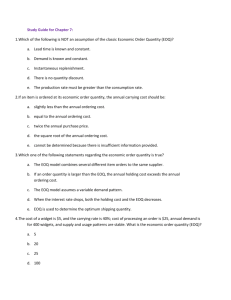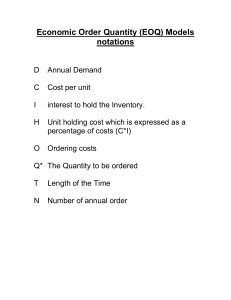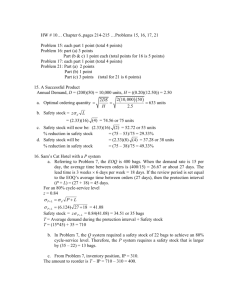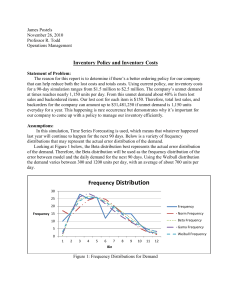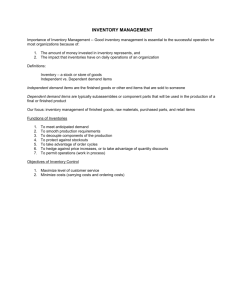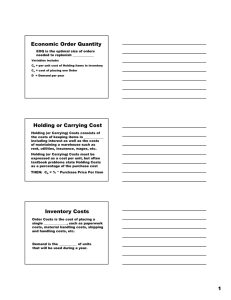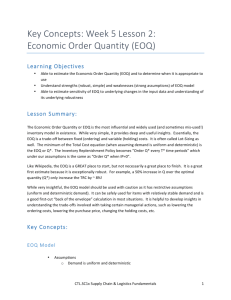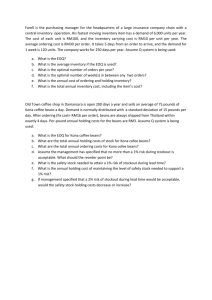Doc - User Solutions, Inc.
advertisement
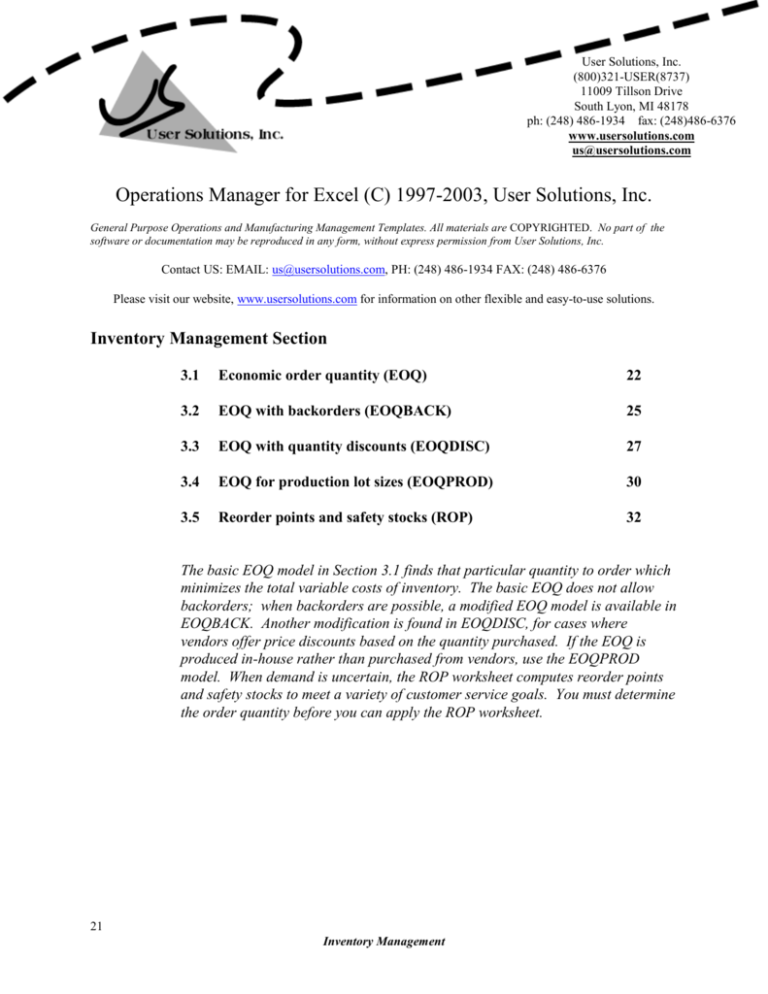
User Solutions, Inc.
(800)321-USER(8737)
11009 Tillson Drive
South Lyon, MI 48178
ph: (248) 486-1934 fax: (248)486-6376
www.usersolutions.com
us@usersolutions.com
Operations Manager for Excel (C) 1997-2003, User Solutions, Inc.
General Purpose Operations and Manufacturing Management Templates. All materials are COPYRIGHTED. No part of the
software or documentation may be reproduced in any form, without express permission from User Solutions, Inc.
Contact US: EMAIL: us@usersolutions.com, PH: (248) 486-1934 FAX: (248) 486-6376
Please visit our website, www.usersolutions.com for information on other flexible and easy-to-use solutions.
Inventory Management Section
3.1
Economic order quantity (EOQ)
22
3.2
EOQ with backorders (EOQBACK)
25
3.3
EOQ with quantity discounts (EOQDISC)
27
3.4
EOQ for production lot sizes (EOQPROD)
30
3.5
Reorder points and safety stocks (ROP)
32
The basic EOQ model in Section 3.1 finds that particular quantity to order which
minimizes the total variable costs of inventory. The basic EOQ does not allow
backorders; when backorders are possible, a modified EOQ model is available in
EOQBACK. Another modification is found in EOQDISC, for cases where
vendors offer price discounts based on the quantity purchased. If the EOQ is
produced in-house rather than purchased from vendors, use the EOQPROD
model. When demand is uncertain, the ROP worksheet computes reorder points
and safety stocks to meet a variety of customer service goals. You must determine
the order quantity before you can apply the ROP worksheet.
21
Inventory Management
3.1 Economic order quantity (EOQ)
The purpose of the EOQ model is simple, to find that particular quantity to order which
minimizes the total variable costs of inventory. Total variable costs are usually computed on an
annual basis and include two components, the costs of ordering and holding inventory. Annual
ordering cost is the number of orders placed times the marginal or incremental cost incurred per
order. This incremental cost includes several components: the costs of preparing the purchase
order, paying the vendor's invoice, and inspecting and handling the material when it arrives. It is
difficult to estimate these components precisely but a ball-park figure is good enough. The EOQ
is not especially sensitive to errors in inputs.
The holding costs used in the EOQ should also be marginal in nature. Holding costs include
insurance, taxes, and storage charges, such as depreciation or the cost of leasing a warehouse.
You should also include the interest cost of the money tied up in inventory. Many companies
also add a factor to the holding cost for the risk that inventory will spoil or become obsolete
before it can be used. Annual holding costs are usually computed as a fraction of average
inventory value. For example, a holding rate of .20 means that holding costs are 20% of average
inventory. What is average inventory? A good estimate is half the order quantity. Here's the
reasoning: when a new order arrives, we have the entire order quantity on hand. Just before the
new order arrives, stocks are usually near zero. Thus the average inventory on hand is the
average of the high point (the order quantity) and the low point (zero), or half the order quantity.
To see how the EOQ is computed, look at Figure 3-1, a template used by the Rebel Distillery in
Shiloh, Tennessee. Each year the company requires 40 charred oak barrels for aging its fine
sour-mash bourbon. A local supplier builds the barrels for Rebel and other distilleries in the area
at a unit price of $250. Rebel uses costs of $25 per order and .125 for holding inventory. The
EOQ is 8 units per order. If Rebel orders 8 units at a time, the total variable cost per year is
minimized at $250. You can prove that this is correct by using the table starting at row 23. If
Rebel orders once per year, the order cost is $25. Holding cost is $625, computed as follows:
The order size is 40 units and average inventory is 20 units. Then 20 x $250 x .125 = $625.
Total variable cost is $25 + $625 = $650. Two orders per year result in 2 x $25 = $50 in
ordering cost. The order size is 40/2 = 20 and average inventory is 10 units. Then 10 x $250 x
.125 = $312.50. Total variable cost is $50 + $312.50 = $362.50, and so on. The minimum
occurs at 5 orders per year, the point at which total ordering and holding costs are equal. This is
always true. Minimum total cost occurs when ordering and holding costs are equal.
22
Inventory Management
Figure 3-1
1
2
3
4
5
6
7
8
9
10
11
12
13
14
15
16
17
18
19
20
21
22
23
24
25
26
27
28
29
30
31
32
33
A
EOQ.XLS
B
C
D
E
F
ECONOMIC ORDER QUANTITY
HOLDING COST EXPRESSED AS RATE
INPUT:
Annual usage in units
40
Unit price
$250.00
Cost per order
$25.00
Holding rate
0.125
Working days per year
250
OUTPUT:
Total dollar value used per year
$10,000.00
Number of orders per year
5
Total ordering cost per year
$125.00
Total holding cost per year
$125.00
Total variable cost per year
$250.00
Average inventory investment $
$1,000.00
Number of days supply per order
50
EOQ in units of stock
8
EOQ in dollars
$2,000.00
Nbr orders Order cost
1
$25.00
2
$50.00
3
$75.00
4 $100.00
5 $125.00
6 $150.00
7 $175.00
8 $200.00
9 $225.00
10 $250.00
Holding cost
$625.00
$312.50
$208.33
$156.25
$125.00
$104.17
$89.29
$78.13
$69.44
$62.50
G
H
HOLDING COST IN DOLLARS
INPUT:
Annual usage in units
Cost per order
Annual holding cost per unit
Working days per year
OUTPUT:
Number of orders per year
Total ordering cost per year
Total holding cost per year
Total variable cost per year
Average inventory investment units
Number of days supply per order
EOQ in units of stock
Total var cost
$650.00
$362.50
$283.33
$256.25
$250.00
$254.17
$264.29
$278.13
$294.44
$312.50
23
Inventory Management
I
40
$25.00
$31.25
250
5
$125.00
$125.00
$250.00
4
50
8
Here is a quick summary of how to interpret the output cells. Total dollar value used per year is
annual usage in units times the unit price. The number of orders is the annual usage in units
divided by the EOQ. Total ordering cost is number of orders times cost per order. Total holding
cost is average investment times the holding rate. Average investment is half the EOQ times the
unit price. Number of days supply per order is 250 divided by the number of orders. The EOQ,
or number of units per order is the standard formula:
EOQ = [(2 x annual usage x cost per order)/(unit price x holding rate)]1/2
Why don't we include the purchase cost of the inventory in this calculation? It is not a variable
cost. We have to purchase the inventory in any event. The problem is to minimize those costs
that vary with the quantity purchased at one time.
If you are uncertain about the input values to the EOQ, do sensitivity analysis by using a range of
different values. For example, at Rebel, management felt that the actual order cost was
somewhere in the range of $20 to $30. This gives a range of order quantities from 7 to 9 units, so
the 8-unit EOQ looks reasonable. Rebel was also concerned about the holding rate. Estimates in
the range of .10 to .15 were tested, using an order cost of $25. Again, the EOQ varied in the
range 7 to 9 units. Click on the graph tab in the EOQ workbook for another view of cost
sensitivity. The graph shows variable costs versus the number of orders placed per year. The
total cost curve is relatively flat in the region of the EOQ (5 orders per year).
When the holding cost is expressed as dollars per unit per year rather a rate, an alternative model
is available for computing the EOQ (columns F – I in Figure 3-1). Note that the unit price is not
necessary in this alternative model.
24
Inventory Management
3.2 EOQ with backorders (EOQBACK)
Backorders are common in inventories held for resale to customers. The EOQ model can be
modified to handle backorders by including one more cost, the cost per unit backordered. This
cost is extremely difficult to assess. In theory, the backorder cost should include any special cost
of handling the backorder, such as the use of premium transportation, and any cost associated
with loss of customer goodwill. As a surrogate for the true backorder cost, most companies use
the profit per unit.
The backorder model has been employed for some time by the Ryan Expressway Nissan
dealership in Freeport, Texas. Figure 3-2 is an analysis of inventory policy for the Nissan
Maxima SE, which costs Ryan $17,400. Ryan sells about 120 SEs per year. Order cost
(primarily transportation) is $225 per unit. Ryan's holding rate is .1875 of average inventory
value. As a backorder cost, Ryan uses profit per unit, which averages $730. The model tells
Ryan to order an EOQ of 9.51 or about 10 cars. Backorders build up to about 7.77 cars by the
time each EOQ arrives, and the average number on backorder during the order cycle is 3.18.
Total variable cost is $5,675.59.
The formula for the EOQ with backorders is:
EOQ with backorders = {[(2 x annual usage x cost per order)/(holding cost)] x
[(holding cost + backorder cost)/(backorder cost)]}1/2
The holding cost is unit price times the holding rate. Note that the square root is taken for the
entire quantity inside the curly brackets.
In the worksheet, enter a backorder cost of zero for an EOQ of 4.07, with total costs of
$13,273.09. This is the same result as the standard EOQ model. Now, enter the backorder cost
of $730. This increases the EOQ to 9.51, and total costs are reduced to $5,675.59.
Why did total costs go down? The last term in the equation above forces the backorder model to
yield a smaller order quantity and therefore a smaller average inventory than the standard EOQ.
In this example, average inventory goes down to almost nothing (0.16 cars) because as soon as
the EOQ arrives, we use most of it to fill backorders. Of the 9.51 cars in the EOQ, 7.77 go to fill
backorders, leaving less than two cars in stock.
The backorder model works well for Ryan because financing the inventory is so expensive. It is
much less expensive to incur backorders and fill them when the EOQ arrives than it is to hold
inventory. Of course, this is a risky policy and the backorder model must be used with caution.
The model assumes that customers are willing to wait on backorders and are not lost to the
company. If customers are lost, then the model is inappropriate. There are other models that
account for lost customers but they are rarely used in practice because of the risks involved.
25
Inventory Management
Figure 3-2
A
1
2
3
4
5
6
7
8
9
10
11
12
13
14
15
16
17
18
19
20
21
22
23
24
25
26
27
28
EOQBACK.XLS
B
C
EOQ WITH BACKORDERS
HOLDING COST EXPRESSED AS RATE
INPUT:
Annual usage in units
120
Unit price
$17,400.00
Cost per order
$225.00
Holding rate
0.1875
Backorder cost per unit
$730.00
Working days per year
300
OUTPUT:
Order quantities:
EOQ in units
9.51
Number of days supply per order
23.79
EOQ in dollars per order
$165,551.04
Backorder cost:
No. of units backordered when the EOQ arrives
7.77
Average units backordered
3.18
Annual backorder cost
$2,318.93
Ordering cost:
No. of orders per year
12.61
Annual ordering cost with backorders
$2,837.80
Holding cost:
Average inventory
0.16
Annual holding cost with backorders
$518.87
Total annual cost:
Backorder cost + ordering cost + holding cost
$5,675.59
D
HOLDING COST IN DOLLARS
INPUT:
Annual usage in units
Cost per order
Annual holding cost per unit
Backorder cost per unit
Working days per year
OUTPUT:
Order quantities:
EOQ in units
Number of days supply per order
Backorder cost:
No. of units backordered when the EOQ arrives
Average units backordered
Annual backorder cost
Ordering cost:
No. of orders per year
Annual ordering cost with backorders
Holding cost:
Average inventory
Annual holding cost with backorders
Total annual cost:
Backorder cost + ordering cost + holding cost
26
Inventory Management
E
120
$225.00
$3,262.50
$730.00
300
9.51
23.79
7.77
3.18
$2,318.93
12.61
$2,837.80
0.16
$518.87
$5,675.59
Some companies refuse to accept the idea that any specific cost is incurred for backorders.
However, these companies still use the model in Figure 3-2 as a means of determining the EOQ
that will yield some target number of backorders. This is done by treating the backorder cost as a
control knob. We turn the knob until the target number of backorders is reached. In Ryan's case,
what backorder cost should be employed to have only 2 cars on backorder when the EOQ
arrives? The answer is $5,200. Enter this value in the model and you get 2 cars on backorder,
with an EOQ of 5.19. This represents about a 13-day supply of cars, compared to about 24 days
with a backorder cost of $730.
If holding costs are stated in dollar terms use the alternate model in Figure 3-2. You can repeat
this example using a holding cost of $3,262.50, which is the holding rate of .1875 x the unit price
of $17,400.
3.3 EOQ with quantity discounts (EOQDISC)
Many companies blindly purchase in large quantities to get discount prices without considering
all the tradeoffs involved. The costs may well outweigh any savings in purchase price. The
EOQDISC model helps you analyze quantity discount offers and make better purchasing
decisions.
In Figure 3-3, the Bellaire Printing Company in Bellaire, Texas, uses 1,000 drums of binding
glue per year. Up to 499 drums can be purchased at a price of $50 per drum. For 500 or more
drums the price is $48. At first glance, this is a good deal because savings in purchase costs are
$2,000 per year (1,000 drums x $2 discount). But when total costs are considered, the discount
plan costs the company more.
EOQDISC first computes the economic order quantity at standard price. This is shown in cell
B11 and rounded up to the nearest integer in cell B12. Next, the model computes the holding
cost of the inventory. The dollar value of an order is computed in cell B14. Just after an order is
received the entire order is on hand. When all stock is consumed, inventory is zero. Thus
average inventory on hand is estimated at half the order value. The annual holding cost is the
holding rate times average inventory or $463.75.
Another cost is associated with purchasing the item. The number of orders per year is 18.87,
obtained by dividing the annual usage by the order quantity. It costs $25 to process an order, so
the annual purchasing cost is 18.87 x $25 = $471.70. The final cost is for the item itself.
Multiplying the unit price times the annual usage yields $50,000.00. Finally, the sum of holding,
purchasing, and item costs is $50,935.45.
27
Inventory Management
Figure 3-3
A
1
2
3
4
5
6
7
8
9
10
11
12
13
14
15
16
17
18
19
20
21
EOQDISC.XLS
INPUT:
Annual usage in units
Unit price
Cost per order
Holding rate
Min. order qty. to get discount
OUTPUT:
Trial order quantity
Final order quantity
Holding cost:
Dollars in one order
Average inventory in dollars
Annual carrying cost
Purchasing cost:
Number of orders per year
Annual purchasing cost
Cost of the inventory item:
Total cost per year:
B
C
D
EOQ WITH QUANTITY DISCOUNTS
E
F
Standard
price
1,000
$50.00
$25.00
0.3500
0
Discount
plan 1
1,000
$48.00
$25.00
0.3500
500
Discount
plan 2
1,000
#N/A
$25.00
0.3500
#N/A
Discount
plan 3
1,000
#N/A
$25.00
0.3500
#N/A
Discount
plan 4
1,000
#N/A
$25.00
0.3500
#N/A
53.45
53
54.55
500
#N/A
#N/A
#N/A
#N/A
#N/A
#N/A
$2,650.00
$1,325.00
$463.75
$24,000.00
$12,000.00
$4,200.00
#N/A
#N/A
#N/A
#N/A
#N/A
#N/A
#N/A
#N/A
#N/A
18.87
$471.70
$50,000.00
$50,935.45
2.00
$50.00
$48,000.00
$52,250.00
#N/A
#N/A
#N/A
#N/A
#N/A
#N/A
#N/A
#N/A
#N/A
#N/A
#N/A
#N/A
28
Inventory Management
The same analysis is performed for the discount plan in column C. The trial EOQ turns out to be
54.55 units, too small to get the discount, so the order quantity is rounded up to the minimum
that must be purchased. The result is a total cost of $52,250, about 2.5% more than the total cost
at standard price.
Now let's do some sensitivity analysis. Suppose that you are uncertain about the cost per order.
Try a cost per order of $50 and see what happens. You get annual costs of $51,322.89 at the
standard price and $52,300 at the discount price. Now try an ordering cost of $10. The costs are
$50,591.62 at the standard price and $52,220 at the discount price. Thus, even if the ordering
cost is wrong by a wide margin, you should not take this discount. You may also be uncertain
about the annual usage or the holding cost per dollar. Again, sensitivity analysis of these factors
is easy to do.
If you are in a position to bargain with the vendor on prices, use EOQDISC to find the breakeven
price. This is the price at which you are indifferent about taking the discount because the annual
costs for the standard price and the discount price are the same. You can use the breakeven price
as the starting point for negotiating a better discount plan, one that benefits both vendor and
customer. A little experimenting with EOQDISC shows that $46.79 (a 6.4% discount) is the
breakeven price. If you want to check this result, don't forget to reset the ordering cost to $25.
With this discount, total costs are about the same for both standard and discount prices.
Vendors sometimes offer several different price/quantity plans, so EOQDISC is set up to
evaluate four discount plans at once. To analyze a new problem, the first step is to make new
entries in the input data cells in column B for the standard price plan. Data for annual usage, cost
per order, and holding rate are common to all plans, so formulas automatically repeat this
information in columns C - F. Now enter unit prices and minimum order quantities. When data
entry is complete, the total cost per year is automatically displayed in row 21.
EOQDISC requires input of the holding rate rather than holding cost in dollars. You can convert
to a holding rate by dividing the holding cost in dollars by the unit price.
29
Inventory Management
3.4 EOQ for production lot sizes (EOQPROD)
Alvin Air Systems in Alvin, Texas, produces repair and maintenance items for commercial air
conditioning systems. Alvin cannot use the standard EOQ for determining production lot sizes.
One problem is that the standard EOQ assumes that an order quantity or lot of material is
received all at once. At Alvin, most production lots take some time to complete and parts are
placed in stock on a daily basis until the run is over. A related problem is that substantial sales
usually occur before the run is over. To solve these problems, Alvin uses the modified EOQ
model in Figure 3-4. The data are for a rubber seal used in water pumps. Usage (sales) is 5,000
units per year at a price of $8.00 each. Setup cost, the cost of cleaning supplies and the labor
time to prepare the equipment, is $125 per run. Alvin uses a holding rate of .20. Sales occur at
an average rate of 20 units per day, while 100 units per day are produced. The output section
shows that maximum investment is $6,324.56 but the EOQ in dollars is $7,905.69. Why? The
EOQ must be larger than maximum investment to account for sales made during the production
run. The formula for the EOQ with production lot sizes is:
EOQ for production lots = {(2 x annual usage x cost per order)/
[(unit price x holding rate) x (1 - sales rate/production rate)]}1/2
The formula is the same as the standard EOQ except that the denominator of the fraction includes
the term (1 - sales rate / production rate). This term inflates the EOQ to account for sales during
the production run.
30
Inventory Management
Figure 3-4
A
1
2
3
4
5
6
7
8
9
10
11
12
13
14
15
16
17
18
19
20
21
22
23
EOQPROD.XLS
HOLDING COST EXPRESSED AS RATE
INPUT:
Annual usage in units
Unit price
Setup cost per run
Holding rate
Sales rate in units per day
Production rate in units per day
Working days per year
OUTPUT:
Total dollar value used per year
Number of production runs per year
Total ordering cost per year
Total holding cost per year
Total variable cost per year
Average inventory investment
Maximum inventory investment
Number of days supply per run
Number of days required to produce EOQ
Number of units per run (EOQ)
Number of dollars per run (EOQ$)
B
C
D
E
EOQ FOR PRODUCTION LOT SIZES
5,000
$8.00
$125.00
0.20
20
100
250
$40,000.00
5.06
$632.46
$632.46
$1,264.91
$3,162.28
$6,324.56
49.41
9.88
988.21
$7,905.69
F
HOLDING COST IN DOLLARS
INPUT:
Annual usage in units
Annual holding cost per unit
Setup cost per run
Sales rate in units per day
Production rate in units per day
Working days per year
OUTPUT:
Number of production runs per year
Total ordering cost per year
Total holding cost per year
Total variable cost per year
Average inventory investment (units of stock)
Maximum inventory investment (units of stock)
Number of days supply per run
Number of days required to produce EOQ
Number of units per run (EOQ)
31
Inventory Management
G
5,000
$1.60
$125.00
20
100
250
5.06
$632.46
$632.46
$1,264.91
395.28
790.57
49.41
9.88
988.21
3.5 Reorder points and safety stocks (ROP)
When demand is uncertain, inventory investment from the EOQ model should be supplemented
with safety stock. ROP (Figure 3-5) is a worksheet used to compute safety stocks and reorder
points (ROPs) at Channelview Inspection Company, a Houston-area firm that performs a variety
of inspection, testing, and cleaning operations on pipe destined for use in oil and gas fields. The
ROP model helps manage the maintenance parts and supplies used in this work. Look first at
Part A. The data are for wire brushes used to clean the interior of pipe joints. Since work is
delayed when brushes are out of stock, management wants no more than a 10% probability of
shortage. About 2,000 brushes are used per year. The EOQ, or order quantity, is 200 units and
leadtime demand averages 166.7 units. Since the volume of pipe received from customers varies,
there is variation in leadtime demand, with a standard deviation of 60 units. Leadtime is 1 month
and the length of the forecast interval (the time period covered by the forecast) is also 1 month.
When the stock of brushes falls to a certain level, called the reorder point, or ROP, we should
reorder the EOQ of 200 units. This level should cover expected leadtime demand plus enough
safety stock to give a 10% chance of shortage before the order arrives. The ROP is 243.6 units in
cell D21. Let's work through the input and output cells to see how this value is determined.
First, leadtime demand is defined as the total inventory usage expected to occur during a stock
replenishment cycle. This cycle is measured from the time the replenishment order is released
until it is received. The standard deviation is a measure of variation in leadtime demand. If there
is no variation, the standard deviation is zero. As the standard deviation increases, demand
becomes more uncertain, and we need more safety stock.
The standard deviation of leadtime demand may be known or it may have to be estimated from a
forecasting model. The square root of the MSE of the forecast errors from one of the smoothing
models in Chapter 2 is an approximate standard deviation of leadtime demand if leadtime is one
time unit (week, month, or quarter). That is, the MSE in the smoothing models is always
computed for 1-step-ahead forecasts. When the number of time periods in leadtime and the
number of periods used to compute the standard deviation do not match, the standard deviation
must be adjusted. This is done in cell D18 by multiplying the standard deviation by the square
root of (D13/D14) or (periods in leadtime)/(periods used in standard deviation).
Now we need to determine the number of adjusted standard deviations that should be used in
safety stock. Cell D19 contains a formula that is equivalent to a table lookup from the normal
distribution. This cell uses the probability in cell D8 to determine the number of standard
deviations (often called a Z-score) needed to meet that probability target. Safety stock in cell
D20 is the number of standard deviations times the size of the adjusted standard deviation. The
ROP in D21 is the level of stock at which a new order is placed: the sum of leadtime demand
plus safety stock.
32
Inventory Management
Figure 3-5
1
2
3
4
5
6
7
8
9
10
11
12
13
14
15
16
17
18
19
20
21
22
23
24
25
26
27
28
29
30
31
32
33
34
35
36
37
38
39
40
41
42
43
44
45
46
47
48
49
50
51
52
53
54
55
56
57
A
ROP.XLS
B
C
D
E
F
REORDER POINT (ROP) CALCULATOR
PART A:
What ROP will meet a target
probability of shortage?
INPUT:
Probability of shortage
Annual demand
Order quantity
Demand during leadtime
Std. dev. value
No. periods in leadtime
No. periods of demand
used to compute std. dev.
OUTPUT:
Adjusted std. dev. value
No. of std. devs. (Z)
Safety stock
ROP
No. of annual orders
No. of annual shortages
Average investment
Maximum investment
% ann. sales backordered
OUTPUT:
Adjusted std. dev. value
No. of std. devs. (Z)
H
I
PART B:
What ROP will meet a target
number of annual shortages?
10.0%
2,000.00
200.00
166.70
60.00
1.0
1.0
60.0
1.3
76.9
243.6
10.0
1.0
176.9
276.9
1.4%
PART C:
What shortage values result
from a given safety stock?
INPUT:
Safety stock
Annual demand
Order quantity
Demand during leadtime
Std. dev. value
No. periods in leadtime
No. periods of demand
used to compute std. dev.
G
INPUT:
No. of annual shortages
Annual demand
Order quantity
Demand during leadtime
Std. dev. value
No. periods in leadtime
No. periods of demand
used to compute std. dev.
OUTPUT:
Adjusted std. dev. value
No. of std. devs. (Z)
Safety stock
ROP
No. of annual orders
Average investment
Maximum investment
% ann. sales backordered
Probability of shortage
1.0
2,000.00
200.00
166.70
60.00
1.0
1.0
60.0
1.3
76.9
243.6
10.0
176.9
276.9
1.4%
10.0%
PART D:
What ROP will meet a target %
of annual sales backordered?
76.9
2,000.00
200.00
166.70
60.00
1.0
1.0
60.0
1.3
ROP
243.6
No. of annual orders
No. of annual shortages
Average investment
Maximum investment
% ann. sales backordered
Probability of shortage
10.0
1.0
176.9
276.9
1.4%
10.0%
INPUT:
% sales backordered
Annual demand
Order quantity
Demand during leadtime
Std. dev. value
No. periods in leadtime
No. periods of demand
used to compute std. dev.
1.4%
2,000.00
200.00
166.70
60.00
1.0
1.0
OUTPUT:
Adjusted std. dev. value
No. of std. devs. (Z)
Safety stock
ROP
60.0
1.3
76.9
243.6
No. of annual orders
No. of annual shortages
Average investment
Maximum investment
10.0
1.0
176.9
276.9
Probability of shortage
10.0%
33
Inventory Management
Given this ROP, we can compute several measures of performance for the inventory of brushes.
There are 10 orders per year (annual demand divided by the size of the order quantity). This is
also the number of leadtimes each year, so 10 leadtimes times a 10% probability of shortage on 1
leadtime equals 1 expected shortage per year in cell D24. Average inventory investment in D25
includes two components: half the order quantity plus all of the safety stock. The reasoning for
counting half the order quantity in average investment is explained in section 3.1. Why do we
count all of the safety stock? Sometimes demand will be less than expected and we will have
safety stock left over following a leadtime. Sometimes demand will be greater than expected and
we will use up all safety stock. So we count all of the safety stock in average inventory
investment. The maximum inventory investment that should be on hand at one time occurs just
after an order is received. The maximum is the sum of order quantity plus safety stock. Finally,
cell D27 indicates that about 1.4% of annual sales units will be on backorder at any given time.
Part B of the model is similar to Part A except that the management goal is stated in terms of the
number of shortages per year. When the items in an inventory are ordered different numbers of
times each year, Part B can be used to assign safety stocks such that each item runs out of stock
the same number of times. For example, suppose that one item is ordered 10 times per year and
another is ordered 30 times. If each has a 10% probability of shortage, the first item will run out
of stock once per year and the second will run out 3 times. You can use Part B to assign safety
stocks so that each item has the same number of shortages. Part C is used when you want to
check the shortage protection provided by some predetermined level of safety stock. Part D is
used when you want to meet a goal for the percentage of annual sales backordered.
To solve your own problem in the ROP model, replace the input cells with your own entries.
One potential complication is that some companies compute the MAD of the forecast errors
rather the standard deviation. For the normal distribution, the standard deviation is approximated
by 1.25 times the MAD. Multiply the MAD by 1.25, enter the result as the standard deviation,
and you can use the ROP worksheet as is. Another complication is that it is possible to meet a
goal for the percentage of sales backordered using "negative safety stocks," by purposely running
out of stock. Negative safety stocks are impractical in my opinion and the formulas in ROP do
not work with them. If negative safety stocks occur in ROP, treat the results as an indication of
an error in your input data.
34
Inventory Management

